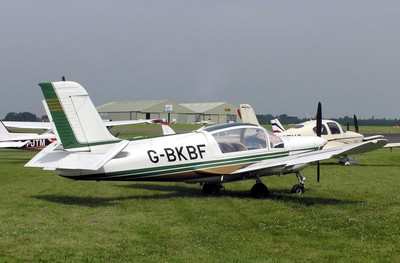 This couldn't have been a lot of fun, but thankfully, the
injuries were minor. A somewhat uncommon Rallye Minerva (file
photo, below) experienced an engine failure after its engine
pretty much destroyed itself from the inside out...
This couldn't have been a lot of fun, but thankfully, the
injuries were minor. A somewhat uncommon Rallye Minerva (file
photo, below) experienced an engine failure after its engine
pretty much destroyed itself from the inside out...
NTSB Identification: NYC08LA280
14 CFR Part 91: General Aviation
Accident occurred Saturday, August 16, 2008 in Fulton, NY
Aircraft: SOCATA MS894A, registration: N31BF
Injuries: 2 Minor.
This is preliminary information, subject to change, and may
contain errors. Any errors in this report will be corrected when
the final report has been completed.
On August 16, 2008, about 1540 eastern daylight time, a Socata
MS894A, N31BF, was substantially damaged during a forced landing
following a loss of engine power approximately 2 miles south of the
Oswego County Airport (FZY), Fulton, New York. The certificated
private pilot and passenger sustained minor injuries. Visual
meteorological conditions prevailed, and no flight plan was filed
for the personal local flight. The flight was conducted under the
provisions of 14 Code of Federal Regulations Part 91.
The airplane was owned by the pilot and based at FZY. It had
been fueled on the morning of the accident with 22.2 gallons and a
report from the lineman was that it was "topped off."
A witness at the FZY airport stated "it was a fun day at the
airport; they were dropping flour at targets on the ground." The
accident airplane had just made its drop and the canopy would have
been open to do so.
An interview with the pilot revealed that after making a low
pass along the drop zone, he pulled up and about 400 feet above
ground level. He then heard a "bang," followed by vibration, and
then the engine stopped. He immediately pitched for a "glide speed
of 90 miles per hour," and flew toward a field. On the final leg of
the approach, the airplane impacted trees, nosed over on touchdown,
and then rotated approximately 180 degrees.
Examination of the airplane by a Federal Aviation Administration
(FAA) inspector revealed, that the airplane impacted trees near the
field where it crashed and was facing the opposite direction of
travel. The right main landing gear remained attached, and the left
main landing gear was separated. The left wing root exhibited
leading edge damage consistent with a tree strike, the right wing
exhibited signs of impact damage from the landing gear outboard to
the wing tip, and was bent upward and aft. The right wing leading
edge slat was separated and on the ground. The flap was detached
from the outboard hinge, but remained attached via the inboard
hinge. The left outboard section of the elevator was bent downward.
Control continuity was verified on all control surfaces. The right
side lower engine cowl was detached and in front of the airplane.
The fuel selector valve was off.
Examination of the cockpit revealed that the throttle control
was in the idle position, the mixture control was in the fuel
cut-off position, the propeller control was in the feather
position, the ignition key was in the "off" position, the fuel
boost pump switch was in the "on" position, carburetor heat was in
the "off" position, and the elevator trim wheel was in a nose up
trim position. No shoulder harnesses were installed in the
airplane.

The airplane was equipped with a Franklin, model 6A-350 series
engine. The engine had an L-shaped hole on top of the crankcase
between the number 3 and 4 cylinder, approximately 2 inches by 3
inches, which exhibited signs similar to that of an object going
through it from the inside to the outside. A connector rod from the
number 3 cylinder was located about 15 feet from the airplane. The
crankshaft was fractured at the number 3 cylinder. Rotation was
accomplished using the propeller for cylinders 1 and 2, and through
the accessory gear drive on the back of the engine for cylinders 4,
5, and 6. The number 3 cylinder was removed and moved freely. The
magnetos remained attached to the engine and exhibited no sign of
damage. The oil filter was removed and opened with metal
contaminates located inside. The airplane was equipped with a two
bladed propeller that exhibited minor rotational scoring.
The airplane was retained by the National Transportation Safety
Board for further examination.
The airplane's last annual inspection was completed on April 9,
2008, at 1,576 hours total time. The pilot purchased the airplane
in October 2007, and at the time of the accident the engine had
approximately 150 total hours in service since overhaul.
The pilot held a private pilot certificate with a rating for
single-engine land and instrument airplane. His most recent FAA
third-class medical certificate was issued August 2007.
 ANN's Daily Aero-Linx (04.13.24)
ANN's Daily Aero-Linx (04.13.24) ANN's Daily Aero-Term (04.13.24): Beyond Visual Line Of Sight (BVLOS)
ANN's Daily Aero-Term (04.13.24): Beyond Visual Line Of Sight (BVLOS) Airborne 04.09.24: SnF24!, Piper-DeltaHawk!, Fisher Update, Junkers
Airborne 04.09.24: SnF24!, Piper-DeltaHawk!, Fisher Update, Junkers Aero-News: Quote of the Day (04.14.24)
Aero-News: Quote of the Day (04.14.24) ANN's Daily Aero-Term (04.14.24): Maximum Authorized Altitude
ANN's Daily Aero-Term (04.14.24): Maximum Authorized Altitude




